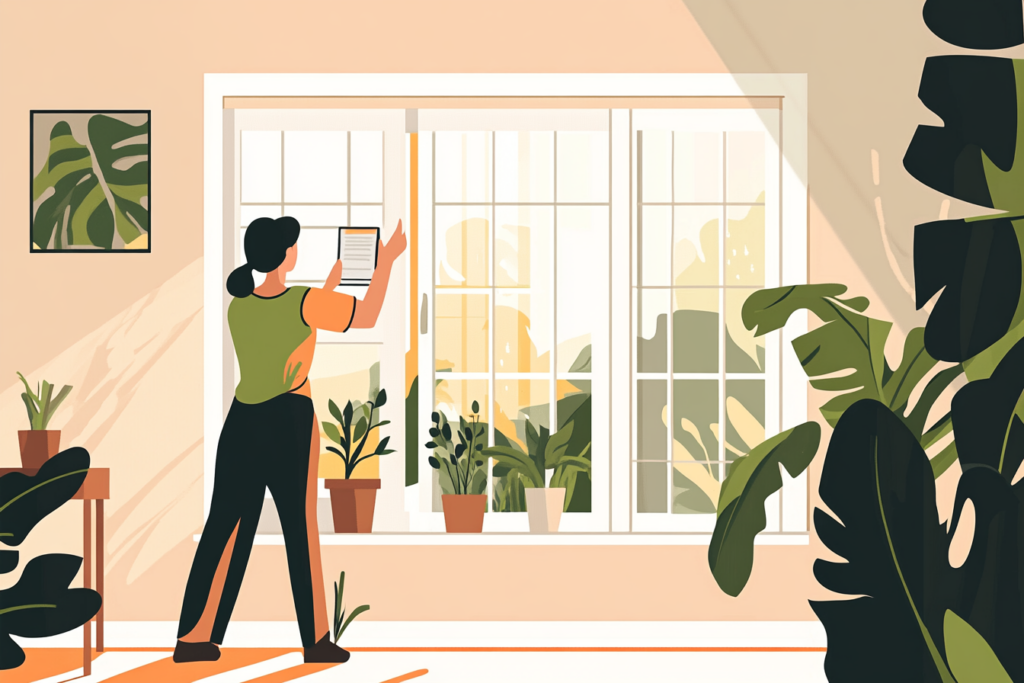Windows can offer amazing natural light and relaxing outside views. However, if they are not maintained properly, they can also cause stress-inducing headaches due to drafts, dirt and costly repairs.
Regular window maintenance keeps them looking great and ensures they function efficiently, saving you money on energy bills and extending their lifespan. Keep reading for 7 DIY window maintenance tips that every homeowner should know how to do to keep their windows in tip-top shape year-round.
1. Clean Regularly
Regular cleaning is the first step to maintaining the appearance and functionality of your home’s windows. Dirty windows can obscure your view, reduce the amount of sunlight that enters your home, and contribute to the degradation of window materials over time.
Cleaning Tips:
- Use the Right Tools: A microfiber cloth or a squeegee is best for cleaning glass without leaving any streaks. Avoid using abrasive materials that can scratch the glass.
- Choose the Right Cleaner: A mixture of water and mild dish soap or a vinegar solution (one part vinegar to two parts water) works well for cleaning glass.
- Clean Frames and Tracks: Remember to clean the window frames and tracks, too. Use a steam cleaner or vacuum with a brush attachment to remove dirt and debris.
2. Inspect and Repair
The seals around your windows are crucial for keeping out drafts, moisture, and pesky insects. Over time, seals and caulking can crack, peel, or disintegrate, allowing air and water to seep into your home and increase your energy bills and affect the overall temperature of your home.
Maintenance Tips:
- Inspect Annually: Check the seals and caulking around your windows at least once per year, especially as the seasons change.
- Re-Caulk When Needed: If you notice gaps or cracks in the caulking, remove any old material with a putty knife and apply new exterior-grade caulk.
- Check Weatherstripping: If your windows have weatherstripping, ensure they are intact and provide a good seal. Replace any damaged weatherstripping to prevent drafts and energy loss.
3. Lubricate Window Tracks and Hinges

If you are anything like us, you’ve likely never thought to lubricate your windows and hinges. Windows that stick, squeak, or are difficult to open and close can be frustrating and may indicate that the tracks or hinges need lubrication.
Lubricating your windows and hinges regularly ensures smooth operation and prevents wear and tear.
Lubrication Tips:
- Clean First: Before lubricating, clean the tracks, hinges, and other moving parts with a brush or vacuum to remove dust and debris.
- Use the Right Lubricant: Silicone spray is ideal for window tracks and hinges because it won’t attract dust or grime. Avoid using oil-based lubricants, which can gum up the works over time.
- Apply Sparingly: A little goes a long way. Apply a small amount to the tracks and hinges, then move the window back and forth to distribute it evenly.
4. Check for Moisture and Condensation
Excess moisture and condensation can damage window frames, lead to mold growth, and indicate poor insulation or ventilation. Addressing these issues early can prevent major issues down the road.
Prevention Tips
- Reduce Indoor Humidity: Utilize exhaust fans in both the kitchens and bathrooms, and consider using a dehumidifier if your home tends to have high humidity levels.
- Inspect for Leaks: Check for signs of water damage around your windows, such as condensation in the window, peeling paint, stained walls, or mold growth.
- Ventilate Properly: Ensure your home is well-ventilated, especially during colder months when condensation is more likely to occur on windows.
5. Replace Damaged Screens
Window screens help keep out insects, debris, and, in some cases, small animals. Over time, screens can become torn or loose, compromising their effectiveness. Regularly inspecting and repairing or replacing screens is an easy way to maintain your windows.
Screen Maintenance Tips:
- Inspect Annually: Check your screens at least once a year for holes, tears, or loose edges.
- Patch Small Holes: Small holes can be patched with a screen repair kit.
- Replace Damaged Screens: If the screen is beyond repair, replacing it is usually straightforward. Most home improvement stores sell pre-cut screens or screen material that you can cut to fit your existing frame.
6. Repaint or Refinish Window Frames
Wooden window frames can deteriorate over time if not properly maintained. Regularly repainting or refinishing window frames helps protect the wood from moisture, UV damage, and rot.
Refinishing Tips:
- Sand and Clean: Sand down the existing finish to remove peeling paint or stains, and clean the surface thoroughly before applying new paint or stain.
- Choose the Right Paint: Use exterior-grade paint or stain that is designed for windows. These products are more resistant to weather and temperature changes.
- Seal the Wood: Apply a clear sealant over the paint or stain to protect the wood and extend the life of the finish.
7. Regularly Inspect for Damage
Regular inspections are key to identifying any issues before they become major problems. Look for signs of wear, such as cracks in the glass, warping of the frames, or difficulty opening and closing windows.
Inspection Checklist:
- Check for Cracks: Cracked or broken glass should be repaired or replaced immediately to maintain insulation and security.
- Examine Frames for Rot or Warping: Wooden frames are particularly vulnerable to moisture damage. Address any signs of rot or warping promptly.
- Test Window Operation: Open and close all windows periodically to ensure they are functioning correctly. Difficulty in operation can indicate problems with the frame, balance system, or other components.
Window Maintenance at Home
Maintaining your windows doesn’t have to be stressful or complicated, but it does require regular attention and work.
By following these seven DIY window maintenance tips, you can keep your windows looking great, operating smoothly, and providing energy-efficient benefits for years to come. Regular upkeep not only saves you money on costly repairs but also enhances the overall comfort and appearance of your home. So roll up your sleeves, make a to-do list, grab your tools, and start maximizing the life of your windows today!
You might also be interested in: Historic Windows: Preservation, Restoration, and Replacement




